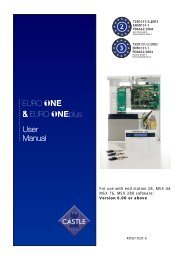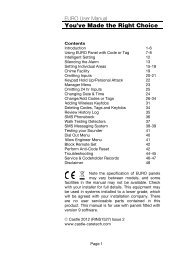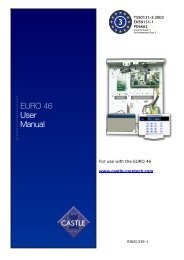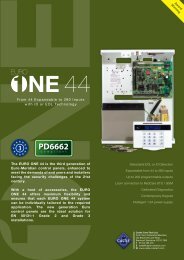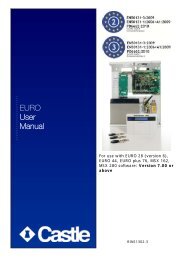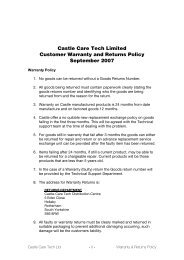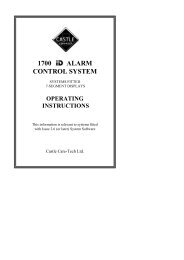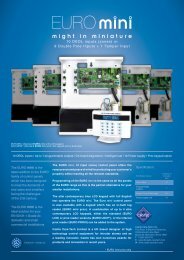UNIVERSAL RELAY MODULE - Castle Care-Tech
UNIVERSAL RELAY MODULE - Castle Care-Tech
UNIVERSAL RELAY MODULE - Castle Care-Tech
Create successful ePaper yourself
Turn your PDF publications into a flip-book with our unique Google optimized e-Paper software.
<strong>UNIVERSAL</strong> <strong>RELAY</strong> <strong>MODULE</strong><br />
INSTALLATION INSTRUCTIONS<br />
This relay module provides the functionality to switch on application of power to the<br />
relay coil, or by application of a low current ‘trigger’ voltage (of either polarity) with<br />
the supply permanently connected.<br />
THESE <strong>MODULE</strong>S ARE NOT SUITABLE FOR SWITCHING MAINS VOLTAGES<br />
There are two basic versions of this product:<br />
SINGLE POLE VERSION (ZA-200):<br />
Relay coil current:<br />
Trigger input current:<br />
Relay switching capacity:<br />
33mA<br />
1 mA<br />
Max 3 Amps, Max 24v DC / 48v AC<br />
NOT SUITABLE FOR SWITCHING MAINS VOLTAGES<br />
Switching polarity selection:<br />
The jumper should be positioned to link the central pin<br />
to either ‘-‘ or ‘+’ as appropriate<br />
DOUBLE POLE VERSION (ZA-300):<br />
Relay coil current:<br />
Trigger input current:<br />
45 mA<br />
1 mA<br />
Relay switching capacity (per pole):<br />
Max 1.25 Amps, Max 24v DC / 48v AC<br />
NOT SUITABLE FOR SWITCHING MAINS VOLTAGES<br />
Switching polarity selection:<br />
The jumper should be positioned to link the central pin<br />
to either ‘-‘ or ‘+’ as appropriate<br />
“QUAD” VERSIONS (Single Pole ZA-400; Double Pole ZA-500):<br />
Both Relay types are available packaged with four relays of either type (but not<br />
mixed!) with supply and trigger connections available at a single, common terminal<br />
block at the right hand edge.<br />
Issue: 1 Page 1 04/06/01
LOW LEVEL TRIGGER SIGNALS<br />
Note that low level signals (eg communicator output pins on an alarm control unit) are<br />
sometimes susceptible to interference if extended from their normal housing. Where possible,<br />
mount the relay inside the same housing, otherwise consider the use of screened cable.<br />
WIRING (This is common to both relay types):<br />
SINGLE VERSIONS<br />
Note that the ‘T’ input is used for the trigger<br />
input of EITHER polarity – selection being made<br />
by suitable location of the jumper as shown.<br />
To wire to switch on application of coil voltage,<br />
simply link ‘T’ to either supply terminal and set<br />
polarity jumper accordingly.<br />
QUAD VERSIONS:<br />
Note that the TRIP input numbers<br />
correspond to numbers at the left-hand end<br />
of the corresponding relay contact terminal<br />
blocks.<br />
Switching polarity is selected individually for<br />
each relay.<br />
OTHER WIRING OPTIONS:<br />
Gating:<br />
A relay may be wired with both the supply and trigger inputs fed from switched<br />
sources, so that BOTH must be triggered before the relay will switch.<br />
Self-latching:<br />
A double pole relay may be wired with one pole switching back onto the trigger input to keep<br />
the relay latched after original trigger has been removed – eg from a pulse. To clear the latch,<br />
remove the latch connection or power by a switch or other suitable means.<br />
<strong>Castle</strong> <strong>Care</strong>-<strong>Tech</strong> Ltd.<br />
North St. Winkfield, Windsor, Berkshire. SL4 4SY<br />
t: Sales: 01344 887788 <strong>Tech</strong>nical Support: 01344 886767<br />
f: 01344 890024 e: sales@castle-caretech.com<br />
INSTRUCT-19<br />
Issue: 1 Page 2 04/06/01



